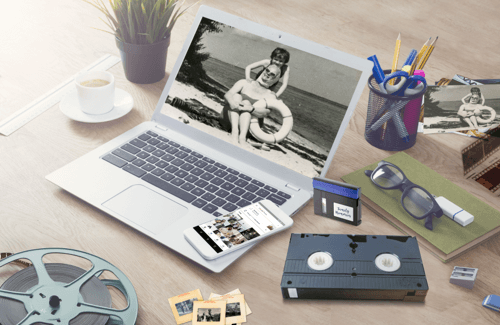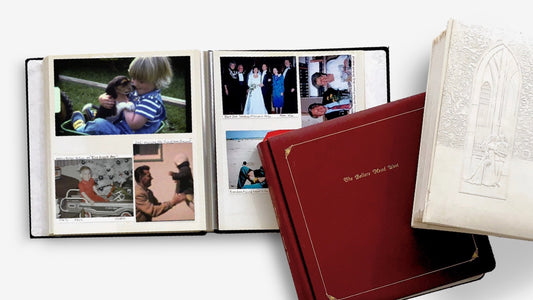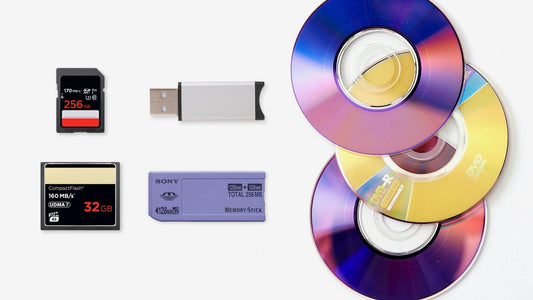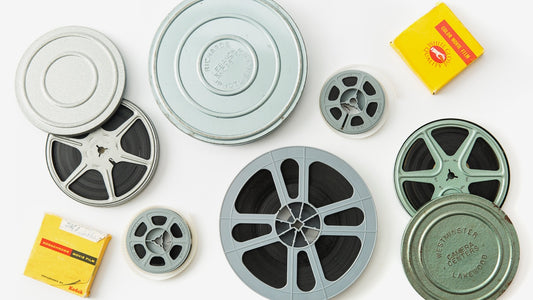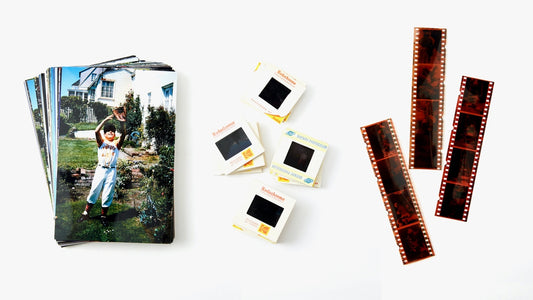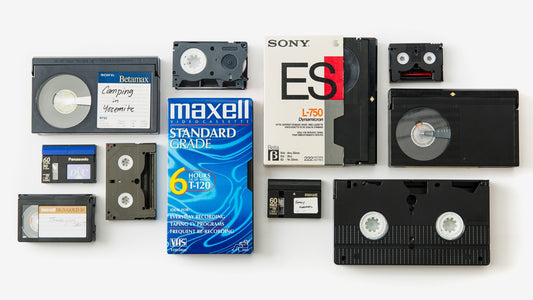We all have a mental image of the classic family shoebox, overflowing with decades of loose, unlabeled photographs. While digitizing your memories saves them from physical decay, you can easily end up with a digital version of that same shoebox—a chaotic folder filled with thousands of files. Without context, a picture is just an image, and a home movie is just footage. The story gets lost. This is where a thoughtful organization system comes in. Learning how to label digitized files is the modern equivalent of writing names and dates on the back of a photograph. It ensures your family’s legacy is not just preserved, but also understood. We’ll show you a simple system to turn that digital mess into a perfectly organized family album.
Key Takeaways
- Create a consistent naming system: Start every filename with the date in a YYYY-MM-DD format, followed by a short description of the event. This simple formula automatically sorts your memories into a timeline and makes them instantly searchable.
- Tell the story with metadata: Go beyond the filename by adding tags for people, locations, and keywords directly to your files. This is the digital equivalent of writing on the back of a photo, ensuring the context behind your memories is preserved for future generations.
- Protect your archive with backups: Safeguard your hard work by following the 3-2-1 rule—keep at least three copies of your files on two different types of media (like your computer and an external drive), with at least one copy stored off-site in the cloud.
Why a Naming System Matters for Your Memories
Getting your old home movies and photos digitized is an exciting first step in preserving your family’s history. Suddenly, decades of memories are safe from fading, damage, and decay. But what happens next? You might find yourself with hundreds, or even thousands, of files with generic names like "IMG_2051.jpg" or "VIDEO_003.mp4." While your memories are secure, they aren't exactly accessible. This is where a good naming system comes in.
Taking the time to label your files might seem like a chore, but it’s one of the most important things you can do for your new digital archive. A consistent naming convention turns a chaotic folder of files into a searchable, browsable library of your family’s most precious moments. It’s the difference between a digital junk drawer and a beautifully organized family album. Whether you've just completed a photo transfer or digitized your film reels, a clear system ensures you and your family can actually enjoy these memories for years to come.
Find memories for years to come
Think about looking through these photos 20 years from now. Will you remember the exact date of your cousin’s wedding or the name of the park where you had that family picnic? Details fade over time. Without descriptive file names, you’ll forget the context behind each image, and future generations will have to guess. A file named "1995-07-16_FamilyReunion_SmithPark.jpg" tells a story that "DSC_0482.jpg" never will. Naming your files is like writing notes on the back of a photograph—it ensures the story sticks with the memory for everyone.
Quickly locate any photo or video
Imagine you need to find a specific photo for a birthday slideshow or an anniversary post. Are you going to scroll through thousands of thumbnails, or would you rather type "Dad's 50th Birthday" into a search bar and find it instantly? Naming your files and folders in a consistent way makes them easy for everyone to find. This is especially true for video files, which can be time-consuming to skim through. A clear label on a video transfer file saves you from scrubbing through hours of footage to find that one perfect clip of your daughter’s first steps.
Preserve your family's story
Your photos and videos are more than just digital files; they are pieces of your family’s legacy. Labeling them helps keep the memories alive and ensures the stories behind them aren't forgotten. When you name a file with a date, event, and the people in it, you’re adding a layer of context that builds a richer narrative. This is particularly important when you’re working with old family pictures from an album scanning project. Those details create a story that can be shared for many years, helping future generations connect with their past and understand where they came from.
Avoid digital clutter
We all know what physical clutter looks like, but digital clutter can be just as overwhelming. A folder filled with poorly named files is stressful to look at and difficult to manage. Creating a simple system to organize and label your digital photos helps you declutter your memories and keep them neat and easy to find. It transforms your digital archive from a source of anxiety into a place of joy. A clean, organized collection invites you to explore your memories, not avoid them because they’re too messy to handle.
A Simple System for Naming Your Files
Once you have your digitized memories, the next step is creating an organization system that makes sense. It might sound tedious, but spending a little time naming your files now will save you hours of searching later. Think of it as writing the captions on the back of old photographs for the digital age. A good naming system ensures you can find any memory in seconds, whether it’s a specific holiday photo or a clip from an old home movie. The goal is to turn a chaotic folder of files into a beautifully organized digital archive that tells your family’s story in chronological order.
The key is to create a simple, consistent formula that you can apply to every single file. You don’t need complex software or technical skills—just a clear plan that you can stick to. By following a few straightforward rules, you can build a digital library that’s as easy to browse as a well-kept photo album. This system works for everything, from your latest photo transfer project to decades-old film reels, ensuring your family’s legacy is accessible for generations to come.
Start with the date
The best way to begin any filename is with the date the photo or video was taken. This automatically puts all your files in chronological order when you sort them by name. The most effective format is YYYY-MM-DD (for example, 1995-08-22). This universal format prevents the sorting confusion that can happen with other date styles and ensures your computer lines everything up perfectly. If you don’t know the exact day, don’t worry. You can simply use the year and month (1995-08-00) or even just the year (1995-00-00). The most important part is starting with the time element.
Add a clear description
After the date, add a brief, descriptive name that tells you what’s in the file. Think about what keywords you or a family member might use to search for it later. Include the event, location, or people in the shot. For example, a good description might be Christmas-Morning-at-Grandmas or Hawaii-Vacation-Beach-Sunset. This simple step transforms a generic filename like IMG_2045.jpg into a meaningful label that instantly brings the memory to life. It’s the perfect way to add context to your newly digitized video tapes and home movies.
Keep track of edits
You’ll likely have different versions of some files, especially photos you’ve decided to edit, color-correct, or restore. To avoid confusion, it’s a good idea to label these versions clearly. A simple way to do this is by adding a suffix like _v01, _v02, or _edit to the end of the filename. For example, you might have 1988-06-10_Moms-Wedding_v01.jpg for the original scan and 1988-06-10_Moms-Wedding_v02.jpg for the touched-up version. This helps you keep the original file safe while always knowing which one is the polished final copy you want to share or print.
Know which characters to skip
This is a small technical detail that makes a big difference. Some characters can cause errors or problems with different operating systems and software. As a general rule, avoid using spaces and special characters like &, ?, !, or # in your filenames. Instead, use hyphens (-) or underscores (_) to separate words. For example, instead of Summer Vacation 2003.mov, name the file 2003-07-00_Summer-Vacation.mov. This keeps your filenames clean, universally compatible, and easy for both you and your computer to read without any glitches.
Keep it short and readable
While descriptions are important, you don’t need to write a novel in your filename. Aim for a name that is descriptive but still concise and easy to read at a glance. Long, complicated filenames can get cut off in file explorers and become difficult to manage. Instead of 1992-12-25_Family-Christmas-at-Aunt-Carols-House-Opening-Presents.jpg, try something more direct like 1992-12-25_Christmas-Aunt-Carols_Presents.jpg. The goal is to find that sweet spot where the name gives you all the essential information without being overwhelming to look at.
Stay consistent
The single most important rule is to be consistent. Once you decide on a naming structure, stick with it for every single file in your digital archive. Whether you’re organizing a scanned photo album or a digitized film reel, applying the same logic everywhere is what makes the system work so well. This consistency creates a predictable, easy-to-search library of your most precious moments. It takes a little discipline at first, but the payoff is a perfectly organized collection of memories that you and your family can easily enjoy for years to come.
How to Create a Logical Folder Structure
Once you have a solid naming system, the next step is creating a home for your files. Think of your folder structure as a digital filing cabinet for your memories. A good system means you can find exactly what you’re looking for in seconds, without scrolling through thousands of files. The best approach is the one that makes the most sense to you and that you can stick with consistently. Whether you prefer to organize by date, event, or person, a clear structure will keep your digital archive tidy and accessible for years to come.
Start with broad categories
The easiest way to begin is by thinking big. Create a few main folders for the most general categories of your memories. This is like labeling the main drawers of your filing cabinet. You might create folders like “Family Vacations,” “Holidays,” “Birthdays,” or “School Events.” Don’t overthink it at this stage; just focus on the major themes that run through your collection of photos and videos. This first step helps you sort your memories into manageable groups before you get into the finer details, making the entire process feel less overwhelming, especially after a large photo transfer.
Create specific subfolders
After you’ve established your broad categories, it’s time to add another layer of detail. Inside each main folder, create more specific subfolders. For example, inside your “Family Vacations” folder, you could add subfolders for each trip, like “Hawaii 2005,” “Grand Canyon 2008,” and “Disney World 2012.” Within your “Holidays” folder, you might have “Christmas,” “Thanksgiving,” and “Easter.” This is where your organization really starts to take shape, allowing you to pinpoint specific moments without having to dig through hundreds of unrelated files. It’s all about breaking down your collection into smaller, more logical pieces.
Organize by year or month
A chronological approach is one of the most popular and effective ways to organize a family archive. Start by creating a main folder for each year (e.g., “1995,” “1996,” “1997”). Inside each year’s folder, you can create subfolders for each month or for specific events that happened that year. This method creates a beautiful timeline of your family’s history, making it easy to see how everyone has grown and changed over time. It’s an especially helpful system when you’re working with a large video transfer that covers several decades of memories.
Organize by event
If your memory works more by occasion than by date, organizing by event might be the perfect fit for you. This method involves creating folders based on recurring events, like “Christmas,” “Birthdays,” or “Summer Cookouts.” You can then use subfolders to separate them by year, such as “Christmas > 2001” or “Birthdays > Sarah’s 5th Birthday.” This approach is fantastic for quickly finding all the photos from a specific type of gathering. It’s a great way to manage memories from a film transfer, since old home movies often capture these exact kinds of special family events.
How to nest folders effectively
Nesting is simply the practice of putting folders inside other folders, which you’re already doing if you follow the steps above. An effective nested structure is logical and easy to follow. For example, a path might look like this: Photos > 2003 > July - Beach Vacation > Day 1. The key is to be consistent without going too deep. A structure that’s four or five levels deep is usually manageable. Any more than that, and you might find yourself clicking through an endless series of folders. The goal is to create a clear path to every memory, not a complicated maze.
Add More Detail with Metadata
A good file name is your first step toward an organized digital library, but the real magic happens in the metadata. Think of metadata as all the information you’d write on the back of a printed photograph—the who, what, when, and where that brings a memory to life. Adding these details to your digital files ensures that the stories behind your photos and videos are never lost.
While it might sound technical, editing metadata is usually straightforward. Most photo management apps and even your computer’s operating system have built-in tools to help you add tags, descriptions, and other key details. Taking a little extra time to fill in this information turns your collection of files into a searchable, meaningful family archive that can be cherished for generations. It’s the difference between having a shoebox of old pictures and a beautifully curated family album.
What is metadata?
So, what exactly is metadata? It’s simply data that provides information about other data. In the case of your digital memories, it’s all the extra context attached to a photo or video file. This hidden information can include the date and time the photo was taken, the camera settings used, and even the GPS coordinates of where it was captured. While some of this is added automatically by your camera or smartphone, you can manually add much more, like the names of people in the photo, the event, and a short description. This is how you can organize and label digital files to make them easily searchable later.
Add a story or context
This is where you get to play the role of family historian. Go beyond the basic facts and add a little story or context to your most cherished memories. In the description field of your file’s metadata, write a sentence or two about what was happening. Was it your daughter’s first time seeing the ocean? Your parents’ anniversary party? Mentioning how you felt or a funny moment that happened just out of frame adds a personal touch that future generations will appreciate. These little narratives are what truly preserve your family's story and give life to a static image.
Tag the location
Knowing where a photo was taken can instantly transport you back to that moment. Many modern cameras and smartphones automatically embed GPS data into your files, but older photos from a film transfer won’t have this information. Manually adding the location—whether it’s as broad as “Paris, France” or as specific as “Grandma’s backyard”—is a powerful way to organize your memories. You can then easily sort your entire collection by location to see all the photos from a family vacation or every holiday spent at a specific home. It’s a simple step that makes finding related memories incredibly easy.
Tag who's in the photo
Have you ever looked at an old family photo and wondered who everyone was? Tagging the people in your photos prevents that from happening to your own memories. Take a moment to add the names of every person in the picture to the metadata. This is especially important for group shots from family reunions or weddings. Many photo management programs, like Google Photos or Apple Photos, even use facial recognition to suggest tags, which can speed up the process. This simple act ensures that the faces of your loved ones will always be remembered.
Use keywords and tags
Keywords and tags are your best friends when it comes to creating a searchable digital archive. Think of them as labels you can attach to your files. You can create tags for events (“Christmas,” “Wedding,” “Birthday”), activities (“Hiking,” “Baking”), or even objects (“Vintage Car,” “Family Quilt”). The key is to be consistent. If you decide to use the tag “Family Vacation,” stick with it instead of sometimes using “Family Trip.” This consistency is a core principle for managing image collections and will allow you to find exactly what you’re looking for with a quick search.
Note the technical details
While you’re adding personal stories and tags, don’t forget about the technical details. Some of this information, like the camera model or date taken, is often captured automatically. However, for scanned photos or digitized home movies, you may want to add this information manually. It can be helpful to note who the original photographer or videographer was, especially if you’re combining archives from different family members. After a photo transfer, for example, you could add a tag with the name of the person whose album it came from, preserving another layer of your family’s history.
How to Organize Different Types of Media
While the core principles of naming and folder structures apply to everything, different types of media have their own quirks. A system that works perfectly for thousands of photos might need a few tweaks for hours of video footage or decades of handwritten letters. The key is to adapt your approach slightly for each format, ensuring every memory is easy to find and understand. Let’s walk through how to handle each type of file so your digital archive is neat and functional.
For your photos and images
Photos often make up the bulk of our family archives. After you complete a photo transfer, it's smart to create a consistent naming system. Use names that describe what’s happening in the picture, like FamilyVacation_Hawaii_2005-07-10.jpg. Always try to name your files in the same way, including key details like the date, event, place, or names of people. It’s also a good idea to back up your photos in multiple places. Don't rely only on a single cloud service; keep copies on your computer and an external hard drive for extra security. This way, your precious images are protected from accidental deletion or service changes.
For your videos and films
Video files are typically larger and can cover longer periods than a single photo. Once you have your film transfer files, create folders based on how you want to group them, like by year or major family event. For example, you could have a main folder for "1990s" with subfolders for "Christmas 1995" or "Sarahs 5th Birthday." If a video file is very long, consider using a simple video editor to trim it into shorter, more specific clips. A two-hour holiday video is much easier to watch when it’s broken down into clips like 1995-12-25_Opening-Presents.mp4 and 1995-12-25_Christmas-Dinner.mp4.
For your documents and letters
When organizing scanned documents and letters, clarity is everything. Keep file names short but descriptive so you know what’s inside without having to open it. A good format includes the date, the type of document, and the people involved, such as 1978-05-12_Letter_Grandma-to-Mom.pdf. This makes it simple to search for correspondence from a specific person or time period. When you’re getting things like scrapbooks digitized through an album scanning service, this method helps preserve the context of each item, from newspaper clippings to handwritten notes, telling a more complete story.
For your audio recordings
Audio files without context can be a mystery. Who is speaking? What are they talking about? That’s why adding details is so important. When naming the file, include the speaker, the general topic, and the date, like 1999-07-04_Grandpa-Interview_WWII-Stories.mp3. Go a step further by using the metadata fields to add a more detailed description, keywords, and tags. You can include the location where it was recorded, the names of everyone present, and a brief summary of the conversation. This extra information turns a simple audio clip into a treasured piece of family history.
For mixed media collections
Some events, like a wedding or a milestone anniversary, generate a mix of photos, videos, and scanned documents. The best way to handle these is to create a main event folder, such as 2005-06-18_Wedding_John-and-Jane. Inside that folder, create subfolders for Photos, Videos, and Documents. This keeps everything from that single event together but neatly sorted by type. When saving your files, stick to common formats like JPEG for photos, MP4 for videos, and PDF for documents. These standard file types are more likely to be accessible for years to come, ensuring your memories are safe no matter how technology changes.
Helpful Tools to Keep You Organized
Once you have a system in place, the right tools can make organizing your digital memories feel less like a chore and more like a fun project. You don’t need to be a tech expert to use them, either. Many programs are designed to simplify the process of naming, tagging, and sorting your precious files, saving you a ton of time and effort. From simple renaming apps to full-featured photo libraries, there’s a tool out there that will fit your needs perfectly.
Photo management software
Think of photo management software as the command center for your entire digital collection. These programs are designed to help you organize, edit, and share your photos and videos from one central place. You can use them to add important details like a title, description, keywords, and tags directly to your files. This makes it incredibly easy to search for specific images later on. Popular options like Adobe Lightroom or the free open-source tool digiKam give you powerful ways to keep your growing library in perfect order.
Metadata editors
While most photo managers let you edit metadata, specialized metadata editors give you even more control. These tools allow you to add extra hidden information to your files, almost like writing a note on the back of a physical photograph. You can add detailed descriptions, the story behind the moment, or specific keywords that might not fit in a simple filename. This extra context is invaluable for future generations who will one day look through your family’s digital archive, giving them a richer understanding of the memories you’ve preserved.
Batch renaming tools
If you’ve just completed a big album scanning project and are facing hundreds of files with generic names like “IMG_001.jpg,” a batch renaming tool is your new best friend. Instead of renaming each file one by one, these tools let you rename them all at once based on a pattern you create. For example, you can instantly rename an entire folder to “FamilyVacation_Hawaii_2010_001,” “FamilyVacation_Hawaii_2010_002,” and so on. This saves an incredible amount of time and ensures your naming system stays consistent across the board.
Visual labels and tags
Here’s a creative way to organize your photos at a glance: visual labels. This involves creating small, simple pictures or symbols that represent different categories, like a heart for family events or a palm tree for vacations. You can then add these labels directly onto your images, like a subtle watermark in the corner. This allows you to quickly see what a photo is about without having to read the filename or open the file. It’s a visual shortcut that can make browsing through large folders much faster and more intuitive.
Backup solutions
Organizing your files is only half the battle; keeping them safe is just as important. The best way to protect your memories is to have multiple copies stored in different places. A great rule of thumb is the 3-2-1 backup strategy: keep at least three copies of your data, on two different types of media (like your computer and an external hard drive), with at least one copy off-site (like in cloud storage). Services like Google Drive, Dropbox, or the MemoryCloud account included with your YesVideo order are perfect for that essential off-site backup.
Look for easy-to-use tools
You don’t need to invest in complicated or expensive software to get organized. There are many fantastic, free tools available that are both powerful and easy to learn. Programs like Google Photos, Adobe Bridge, and XnView MP offer robust features for organizing and tagging your files without a steep learning curve. The most important thing is to find a tool that feels comfortable for you. Start with a simple one, and you can always explore more advanced options as your digital archive grows.
How to Maintain Your Digital Archive
Once you’ve organized your digital memories, the next step is to keep them safe for the long haul. A digital archive isn't a "set it and forget it" project. Think of it like a garden—it needs a little attention now and then to stay healthy and accessible. Creating a simple maintenance plan ensures that your hard work pays off and that your family’s legacy remains intact for future generations to enjoy. These simple habits will protect your photos and videos from being lost to technological failures or digital clutter.
Review your system regularly
Set a calendar reminder to check in on your digital archive once or twice a year. During this review, make sure your naming system and folder structure still make sense. As your collection grows, you might find you need a new subfolder or a different way to label a specific event. This is also a great time to create a simple text file that explains your organization method. This "map" is incredibly helpful for other family members and even for your future self when you can’t quite remember the system you set up.
Create a solid backup plan
A single copy of a precious memory is a risky thing. Hard drives can fail, and laptops can get lost or stolen. That’s why having a solid backup plan is non-negotiable for protecting your family’s history. The best approach is to keep your files in at least three places. For example, you can store one copy on your computer’s internal hard drive, a second copy on an external hard drive, and a third copy using a cloud storage service. This ensures that even if one copy is lost, you have others to fall back on. It’s the ultimate peace of mind for your irreplaceable home movies and photos.
Choose the right storage
Choosing the right storage is a key part of your backup plan. Each type of storage offers different benefits. Keeping files on your computer gives you quick and easy access. An external hard drive provides a physical, offline backup that you control completely. Cloud storage services like Google Drive, Dropbox, or iCloud offer off-site protection, which is crucial in case of a fire, flood, or theft at your home. By using a mix of these options, you create a robust safety net for every precious memory, from your old 8mm films to recent digital photos.
Check for quality
During your regular review, take a moment to spot-check a few files. Open a few photos and play a couple of video clips from different folders to make sure they haven't become corrupted. File corruption is rare, but it can happen. It’s also a good time to ensure your metadata—the descriptions, tags, and dates you’ve added—is still attached to your files, especially if you’ve moved them between devices. Starting with a high-quality photo transfer service provides a strong foundation, and these periodic checks ensure your archive remains in perfect condition.
Keep Your Digital Legacy Safe
After putting in the work to organize your precious memories, the next step is making sure they stay safe for generations to come. Protecting your digital files is just as important as preserving the physical originals. A few simple security measures can ensure your family’s story remains intact and accessible only to the people you choose.
Control who has access
You wouldn't leave your family photo albums out for just anyone to see, and the same principle applies to your digital files. By controlling who has access, you can ensure that only authorized family and friends can view or download your memories. This protects your files from being accidentally changed or deleted and helps maintain the integrity of your collection. Most cloud storage services have simple sharing settings that let you grant viewing or editing permissions folder by folder. You can create a private link for close family and a view-only link for a wider circle, giving you complete control over who gets to be a part of your family's digital archive.
Use strong passwords
A strong password is your first line of defense in keeping your digital memories secure. It’s essential for protecting your files from unauthorized access, especially for the accounts where you store them, like Google Drive, Dropbox, or your computer login. Create unique passwords for each service using a mix of uppercase and lowercase letters, numbers, and symbols. A great trick is to use a memorable passphrase, like "Gr@ndmaB@kedC00kies1985!", which is much harder to guess than a simple word. Whether you're protecting digitized photos or files from a digital media transfer, a strong password is a non-negotiable step.
Consider encryption
Think of encryption as a digital lockbox for your files. It adds an extra layer of protection, ensuring that even if someone gains access to your files, they can't read them without the proper decryption key. This might sound technical, but it’s often simpler than you think. Many modern computers, external hard drives, and cloud storage services have built-in encryption options you can easily turn on with just a few clicks. Taking this extra step is a powerful way to add peace of mind, especially for your most irreplaceable memories that you've worked so hard to preserve for the future.
Plan for the future
Hardware can fail and accidents happen, so it’s wise to never keep all your eggs in one basket. A great strategy is to keep copies of your images in at least three places: on your computer, on a separate external hard drive, and in a cloud storage service. This redundancy ensures your digital legacy is preserved even if one copy is lost or corrupted. Once you receive your files from a professional photo transfer, setting up this backup system should be your very next step. It’s a simple habit that safeguards those precious moments for good, so you never have to worry about losing them.
Related Articles
- How to Scan Old Printed Photos to Digital
- Archiving Old Photos: A Guide
- How to Digitize Scrapbooks
- Digitize Photos Near Me: The Ultimate Local Guide
Frequently Asked Questions
This all seems overwhelming. What's the one thing I should do first? Don't try to organize your entire collection in one weekend. The best way to start is to pick one small, manageable batch of memories, like a single holiday or one specific year. Focus only on creating a folder for that event, renaming the files, and adding a few key details. Tackling your archive in these small chunks makes the project feel much less daunting and helps you build momentum.
What should I do if I don't know the exact date for an old photo or video? Don't let a missing date stop you. If you're not sure of the exact day, just use the information you do have. You can format the date as the year and month (1995-08-00) or even just the year (1995-00-00). The main goal is to get your files into a rough chronological order so they tell a story. You can always go back and add more specific details later if you uncover them.
Is it better to organize my folders by year or by event? This really comes down to how you personally remember things. If you think in timelines and want to see your family's story unfold chronologically, organizing by year is a fantastic approach. If you tend to think in terms of occasions, like wanting to find "all our Christmas photos" at once, then organizing by event will feel more natural. There is no wrong answer, so choose the method that makes the most sense to you and stick with it for consistency.
Why is adding metadata so important if I've already named the file? Think of the filename as the title on the front of a photo album and metadata as the handwritten notes inside. Your filename helps you find the right album quickly. The metadata—like who is in the photo, the location, and a short story about the moment—tells you the context. It preserves the details that make the memory special, ensuring future generations will know the story behind the picture.
Do I really need to back up my files in multiple places? Yes, absolutely. Technology can and does fail without warning. A hard drive can crash, a laptop can be stolen, or a cloud service could have an issue. Keeping copies of your memories on your computer, on a separate external drive, and in a cloud service creates a crucial safety net. It ensures that if one copy is ever lost or damaged, your irreplaceable memories are still safe and sound in another location.





